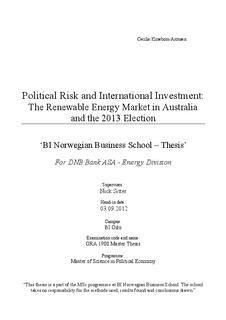| dc.description.abstract | Renewable energy has become a controversial political- and economical topic. The world community are on a global scale experiencing shrinking reserves of non-renewable energy sources such as fossil fuels, which also are proved to be one of the main causes of pollution due to carbon emissions. Thus, it is the obligation of exploiting and developing alternative energy sources for the future, while also finding a better, and more effective way of using energy without polluting as much as we do today. The hurdle is however, since there is still more money to be made on traditional non-renewable energy due to on-going demand and its predictability, the renewable energy markets need help to develop through for example market-based mechanisms such as emission trading schemes as well as government subsidies. This will be an advantage for the market though creating stability and inducing financial incentives and that again will drift new investment into the market. Accordingly, without help from governments, investment will go elsewhere as no one will take the risk of capitalising in a market that is unreliable and immature compared to other energy markets. Global means to decrease pollution such as the Kyoto Protocol has been put in place, yet the renewal of this agreement proves almost impossible since a number of high-polluting countries does not want to sign in fear of it hurting their economies. When the world community finds it hard to agree on a common solution, there is no wonder why this also translates into national borders. Australia is such a case where the two main political parties – the Australian Labor Party and the Liberal Party of Australia disagreeing on how to tackle climate change through what policy tools to use. Yet, both the Opposition and the Government agree on meeting the Renewable Energy Target (RET), producing 20% of all electricity supplied by Australia from renewable sources by 2020. Labor believe in using market-based mechanisms through a carbon pricing scheme to reach this goal, which Liberals threaten to remove if they win office in 2013 arguing that incentive-based mechanisms is all the country needs. Hence the argument is not on the actual result – but on what policy tools used to reach that goal. What policy tools this will be all depend on the behaviour and strategies by the parties in office as well as the opposition in between- and after elections. Thus, for the Australian case it is the policy tools resulting from these strategies that are the real party driven political risk to the renewable market, as well as the outcomes of the next election in 2013. Consequently, this thesis argues that the party driven political risk originates from two linked causes. The 2013 federal election defined as the “risk event” together with the strategies and behaviour laid out by the parties in competition in order to reach their goals whether that is office-, policy-, or votes or a combination of the three. This procedure is defined as the “causal chain” leading up to the risk event. It is the linked process between the causal chain and the risk event that creates the party driven political risk for the renewable market due to the unpredictability of polices and legislations proving a consequence of this behaviour. When parties tailor their policy platforms to attract supporters in order to reach their goals, it can often result in policies that are not ideologically grounded, and instead a result of a strategic pattern in order to reach that set goal. Often altered and unpredictable policies can result in market hesitation, which especially translates into areas reliable on continuous political support such as renewable energy. Besides, since renewables are such a touchy topic, these policies can change quickly or be removed based on what politicians need to do in order to get votes and popularity. By looking at the 2013 election as well as party behaviour and strategies, and how this affects current and future policies and legislations – what can be said about the political risk and especially the party driven political risk in the Australian renewable energy market? The dispute between the Liberal- and Labor party regarding the carbon price has in recent times become one of Australia’s most messy political debates, which has made the country’s renewable energy market very uncertain for businesses and potential investors as well as dividing the electorate on what is the best way forward. DNB Energy Division under DNB Bank ASA, Norway’s biggest financial institution is one player looking into the renewable market in Australia. They are interested in funding projects if they feel that the political risk is acceptable. Thus the objective of this thesis has been to review the possible outcomes of the 2013 election and the current Australian political behaviour and strategies affecting policy and legislations in general, but predominantly in regards to the renewable energy market. This will help give DNB a clearer picture of the party driven political risk they face before making investment decisions. | no_NO |
